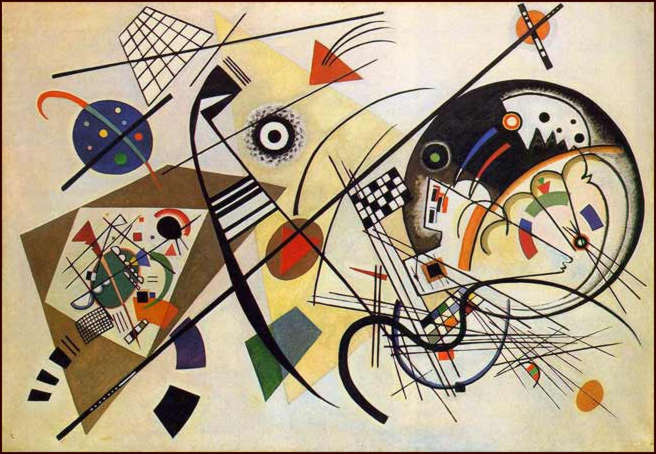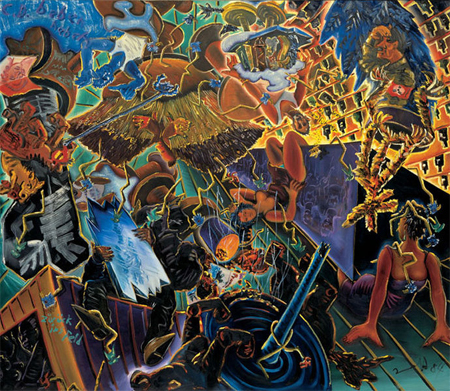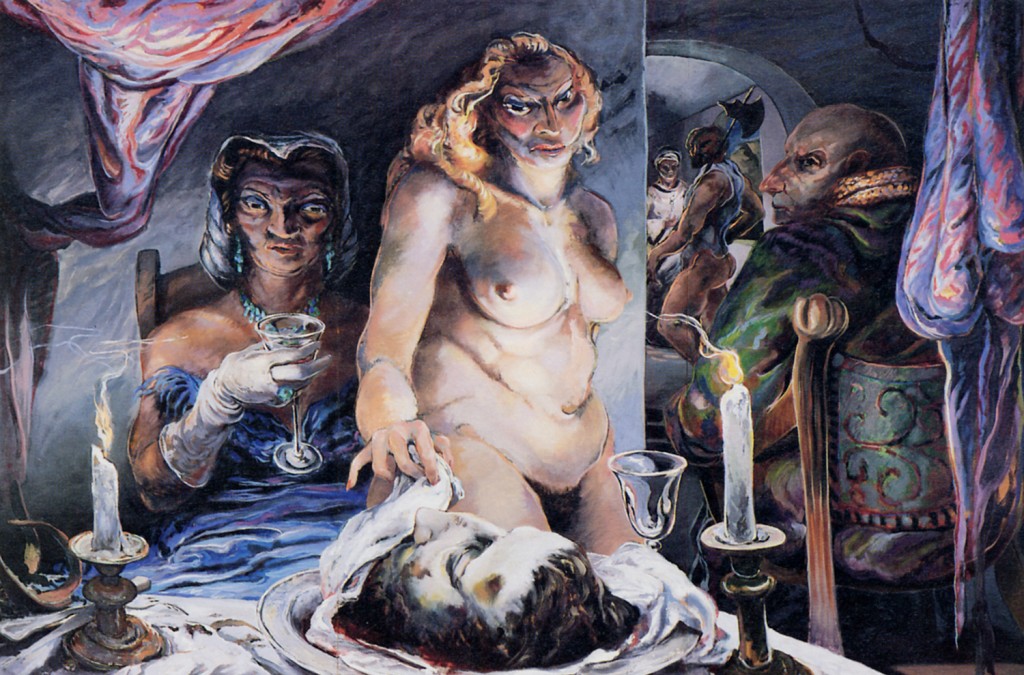…Brecht began to contrive an elaborate complex of stage techniques to produce the celebrated alienation effect, which was designed to stir audiences without exhausting them. He employed many varieties of the play within a play convention to keep the narration detached and avoid “involving” the audience emotionally. He experimented with choruses. He prefaced many scenes with placards or lantern slides that gave away the plotting of the scene to come before suspense could draw people into it. Wherever he could, Brecht exposed the naked wiring, the footlights, the stage flats, the treadmills, or the turntables he was using: this was a stage, he insisted, not life, and you had better be aware of that all the time. DId it work?
In his theoretical attack upon romanticism and emotion Brecht claims to be the advocate of reason. Yet in his writing of plays, Brecht time and again creates scenes that move the audience, in spite of the distancing devices. Because he seems genuinely to believe that his work is free of strong emotion, Brecht makes no effort to suppress or conceal this element. And because our sympathy is continually rebuffed, when emotion manages to take hold of the audience, it may be all the stronger for that. Read More:http://www.teachit.co.uk/armoore/drama/brecht.htma

Donald Kuspit:It is a state of mind in which one no longer feels determined and measured by ordinary reality. Freud regards this "oceanic experience," as it's been called, regressive and narcissistic, which is accurate but misses the reason—indeed, necessity—for such narcissistic regression in a society that seems alien and indifferent, that is, lacking in empathy. In such an emotionally unfacilitative world, which brings with it the threat of psychic disintegration and annihilation, oceanic experience, which is the moment of transcendence or cosmic merger implicit in what I want to call healthy narcissistic regression, affords a sense of insular union with the whole of reality beyond one's immediate reality, one's everyday reality. One is ordinarily forced to comply to it in order to materially survive. Oceanic experience also transports one beyond the socially ugly world at large, and the world is profoundly ugly. One tends, as a society, one tends to submit to it because one realizes that every attempt to revolutionize it is likely to end in failure, that is, the construction of what calls itself a new world order but that demands old-fashioned compliance. Thus mystical experience, which is what Kandinsky's art wants to mediate, becomes an important way of remaining emotionally healthy in an emotionally unhealthy world. More particularly, it becomes the major means of preserving, securing, and protecting the core self in defiance of an intimidating and debilitating social reality. It becomes a way of sustaining a sense of authenticity, to use an old fashioned word, or true selfhood, or at least keep from becoming inwardly contaminated by one's compliant dealings with society. Read More:http://www.blackbird.vcu.edu/v2n1/gallery/kuspit_d/reconsidering_text.htm
Brecht was a master of emphasis. Like Chaplin, whom he admired extravagantly, Brecht could begin with an inherently dramatic situation and so exaggerate the responses of his characters that the whole passage gradually becomes ridiculous. During a crisis of pathos or of tenderness he was likely to bring on a pair of lunatic, ditty singing musicians, or allow his mistreated peasant maid of a heroine, with a broad wink at the audience, to make a thoroughly lewd remark about the hero in a sotto-voce aside. The situation must not settle; thus the brain, not the emotion is engaged. At least in theory.
The most influential technique for achieving the V-effect ( alientation) was the style of acting on which Brecht insisted. He militantly rejected the precepts of Stanislavsky, which required that the actor understand and imitate the character being portrayed so that for all dramatic purposes he will “be” the character. The only justification for the actor’s effort to “feel his way into the character” , according to Brecht, was so that he could ultimately come out “the other side” and observe the character from the standpoint of a seasoned social critic who could add his own explicit criticism to his version of the character.

---Kuspit:But the Neo-Expressionists claimed to be making conceptual painting -- painting that was at once intellectual and empathic without being fixated on one at the expense of the other and without reifying either -- suggesting they were determined to heal the split between feeling and thinking. (The German Neo-Expressionists have convincingly done so.) In contrast, the Neo-Conceptualists maintained an attitude of ironic indifference to feeling -- a seemingly intellectual detachment from and skepticism about it -- however much their ostensible feelinglessness is itself an expression of feeling. Indeed, their emotional nihilism -- their militant eradication of all sensuous-affective expressive traces from their work -- is inseparable from the feeling of self-defeat and self-loss. In contrast, the Neo-Expressionists tried to retrieve, repair, and recapitulate, in an excruciatingly personal, experiential way, the feelings of self-defeat and self-loss -- the sense of the meaninglessness of the self (implicit in the idea of the split between feeling and thinking, that is, the self-division which announces the impending disintegration of the self) -- endemic to modern society and epidemic in postmodern society. Read More:http://www.artnet.com/magazineus/features/kuspit/kuspit8-9-06.asp image:http://www.keywordy.net/arts/art-movements/neo-expressionism.aspx
In practice this meant that the actor would portray a representative character of the proletariat as both raw and seriously sympathetic, or a bourgeois, however superficially graceful or powerful, as an ethical cipher. Caught between what they expected, and what they actually saw and felt, the cultivated German spectator found himself animated by chronic shock and unwilling recognition. This double view of the characters, this critical supernimbus, would form a true and objective image on the psychological retina of the spectator.
ADDENDUM:
Brecht:The spectator was no longer in any way allowed to submit to an experience uncritically (and without practical consequences) by means of simple empathy with the characters in a play. The production took the subject matter and the incidents shown and put them through a process of alienation: the alienation that is necessary to all understanding. When something seems ‘the most obvious thing in the world’ it means that any attempt to understand the world has been given up….

Edward Kippers. ---Later on Ed realized that the art of the post-war period was propelled by ideas that he was at odds with. Some movements, like abstract expressionism, were predicated on a cult of personality, while others, like minimalism or color-field painting, were largely dedicated to the manipulation of art's formal properties. The former tended to degenerate into celebrity, while the latter, despite the most elaborate critical panegyrics, never rose much above the level of inflated decoration. So Ed looked further, to the early part of the twentieth century. "I was drawn to the German Expressionists because they believed art could have some transforming influence on society," he relates. At first he didn't like the individual artists that much, but found their boldness and simplicity attractive, as well as the emotional and confrontational quality of their work. Also, the German Expressionists were quite willing to use religious and Christian imagery. For this reason, Knippers also admired that misplaced expressionist, Georges Rouault, who never took pains to mask his Christian beliefs. He learned a lot about color and paint-handling from Rouault, as well as from the Russian painter Alex Jawelensky. Ed recalls that he had often prayed that he would be guided in the art that influenced him. He was aware of the need for formative influences, and wanted to find common ground with other forms of Christian expression. Both the German Expressionists an
uault had looked back too, back beyond the Renaissance to Medieval or Byzantine sources.--- Read More:http://imagejournal.org/page/journal/articles/issue-3/prescott-profile
…What is ‘natural’ must have the force of what is startling. This is the only way to expose the laws of cause and effect. People’s activity must simultaneously be so and be capable of being different.
It was all a great change.
The dramatic theatre’s spectator says: Yes, I have felt like that too just like me – It’s only natural – It’ll never change – The sufferings of this man appall me, because they are inescapable – That’s great art; it all seems the most obvious thing in the world – I weep when they weep, I laugh when they laugh.
The epic theatre’s spectator says: I’d never have thought it – That’s not the way – That’s extraordinary, hardly believable – It’s got to stop The sufferings of this man appall me, because they are unnecessary That’s great art: nothing obvious in it – I laugh when they weep, I weep when they laugh.
The bourgeois theatre’s performances always aim at smoothing over contradictions, at creating false harmony, at idealization. Conditions are reported as if they could not be otherwise; characters as individuals, incapable by definition of being divided, cast in one block, manifesting themselves in the most various situations, likewise for that matter existing without any situation at all. If there is any development it is always steady, never by jerks; the developments always take place within a definite framework which cannot be broken through.
None of this is like reality, so a realistic theatre must give it up. Read More:http://showme.physics.drexel.edu/thury/A-Effect.html








 COMMENTS
COMMENTS



